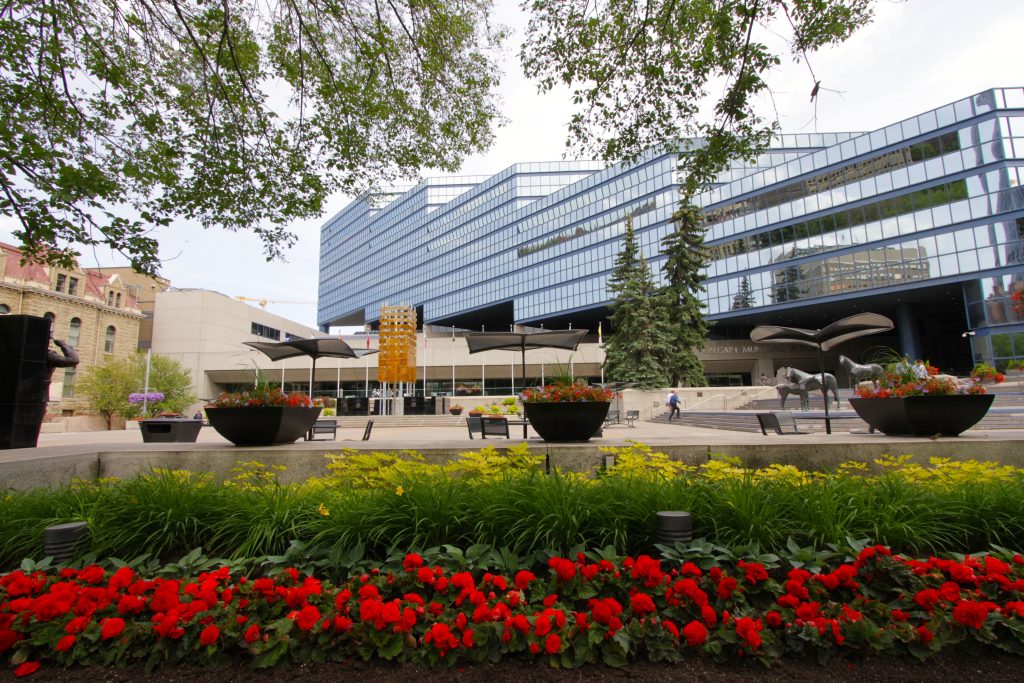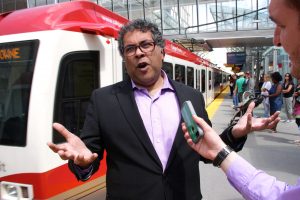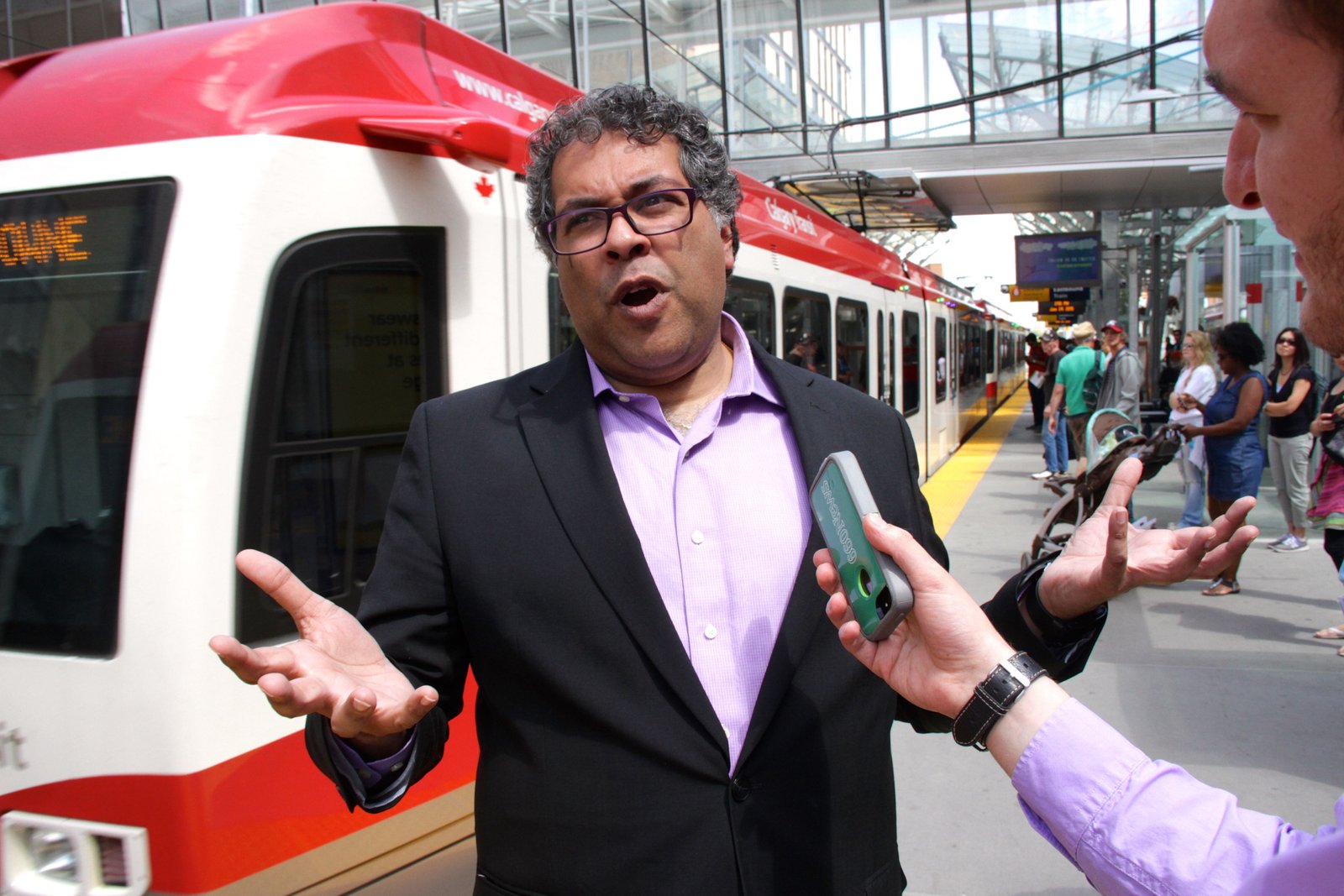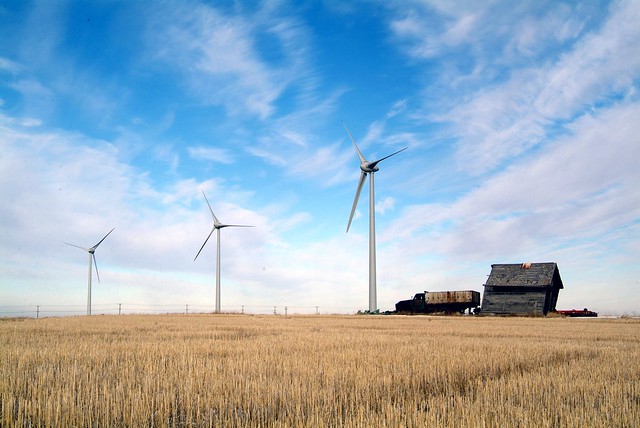By David Dodge & Dylan Thompson
Alberta’s carbon tax is expected to have a relatively minor impact on middle to lower income folks, but what about a major city that buys $60 million worth of power every year? That’s going to cut into some budgets!
It turns out there’s one municipality that’s positioned very well for a carbon tax but its name might surprise you—Calgary. That’s right, the oil and gas capital of Canada is expecting to save $9 million dollars thanks to their forward-thinking embrace of clean energy.

Arsheel Hirji is the leader of sustainable infrastructure for the City of Calgary. Calgary’s investments in renewable energy could save them $9 million per year in carbon levies by 2018. Photo David Dodge, GreenEnergyFutures.ca
“We meet all of our corporate energy demand through renewable sources,” says Arsheel Hirji, leader of sustainable infrastructure for the city of Calgary. “It started with the Ride the Wind program in 2003 where all of our light rail vehicles, our LRT system, was powered with renewable electricity. Now, renewable energy powers everything from the office administrative buildings to the street lights, to the libraries.”
According to Hirji, powering Calgary’s infrastructure costs more than $60 million annually. So, when the city approached ENMAX, their utility provider, with a desire to green that part of their grid, ENMAX was given the financial certainty to develop 120 megawatts of power generation at the Tabor and Kennel Hills wind farms.
“I can point to a wind farm in Tabor and Kennels Hills and say, “That power comes right to our doorstep,” says Hirji.
This forward thinking was undoubtedly justified as a way to reduce emissions or be progressive, but now, Hirji says, this clean energy contract will save Calgary an estimated $9 million in carbon taxes in 2018 and $12 million in 2019.
Renewable energy will save money
Recently, the City of Calgary installed a 153-kilowatt solar system on their Southland Leisure Centre. Hirji confirms the city is looking at a much larger solar system, perhaps as large as 625-kilowatts on its composter facility now under construction.
“We hope that by 2017, in the opening of that composting facility, we’ll also have the unveiling of Calgary’s largest solar plant to date,” says Hiji.
But the city isn’t stopping there. Just in time for the province’s plan to invest $3.4 billion in renewable energy over the next five years, Calgary just completed a solar assessment of all of their civic buildings.

Calgary’s Municipal Building sits adjacent to its historic City Hall that was built in 1911. All of the city’s operations are powered by a power purchase agreement with ENMAX that provides enough renewable energy to cover all of the city’s operations. Photo David Dodge, GreenEnergyFutures.ca
“The city of Calgary owns and operates thousands of buildings,” says Hirji. “That includes recreation centers, office administrative buildings, waste treatment plants, water treatment plants and more. A resource assessment told us that on those rooftops we could install about 26 megawatts of solar.”
Unfortunately, Hirji says Alberta’s municipal solar program isn’t sufficient for the city to take the leap. Currently, the province’s municipal solar program provides up to 20 per cent of the funding for a project, up to a maximum of $300,000. Hirji says two simple changes would make the math add up to a solar boom in cow town.
“I’m simply saying, ‘Increase that number to 30 per cent and a $500,000 cap’, and that makes significant enough of a difference to catch my attention.'”
“The province of Alberta has my commitment that with the right type of financing strategy for the city of Calgary, we could easily see within a three-year period, between three and a half to five megawatts of installed capacity within our municipal boundaries,” says Hirji. For perspective that’s half as much solar that is currently installed in all of Alberta.
The carbon tax is coming
Calgary’s previous investments in renewable energy will now save them millions of dollars in avoided carbon taxes. The question going forward is how much more renewable energy the city will invest in.

It started as a project to power Calgary’s LRT with wind power in 2001, but in 2012 the City entered into an agreement with Enmax to supply all of the city operations, including the LRT with wind power from southern Alberta making the city operations 100% renewable. Calgary needs 144 megawatts of electricity to operate trains and run city operations. That emissions reducing effort is now poised to provide a major payback of almost $10 million per year in avoided carbon taxes. Photo David Dodge, GreenEnergyFutures.ca
“By 2026 the carbon taxation program in Alberta is going to cost the municipality into the tens of millions of dollars,” says Hirji. “By investing in renewables, that tax is effectively avoided because the source of generation is tax free and therefore, our investments will help us hedge against cost increases related to Alberta’s climate change strategy.”
Calgary has a sustainable buildings policy, which can help make buildings solar ready, an idea that unfortunately didn’t come in time for the new composting plant. The city is investing more in energy efficient buildings, installing more LED streetlights, combined heat and power systems and even providing education programs to teach city employed drivers how to save fuel through their driving behaviour.
Speaking of drivers, another big challenge for the city going forward is their vehicle fleet. Currently, transit buses and other city vehicles are primarily diesel-powered. The bus fleet alone is nearly 1,000 vehicles. According to Hirji, Calgary is looking at using electric garbage trucks and doing some pilot programs with electric buses as well. That could add up to a significant savings in a post-carbon tax economy.
For the average person the carbon tax will mean a 6.7 cent per litre increase in gas prices, and one analysis suggested Albertans who fall below a net-income threshold of $47,500 for singles or $95,000 for a couple could get back more in the form of a rebate than they will pay in carbon taxes. Make your next car some more fuel efficient model and you will actually be ahead of the game.
It’s hard to say how many municipalities are as ready for the carbon tax as Calgary is, but one thing is pretty clear—the carbon levy is already inspiring the kind of thinking that will reduce emissions. In the case of Calgary, the city seems poised to avoid paying almost $10 million in carbon taxes and through their solar program they are ready to capture funds through Alberta’s municipal solar programs—money paid in carbon taxes by other, less prepared organizations.


